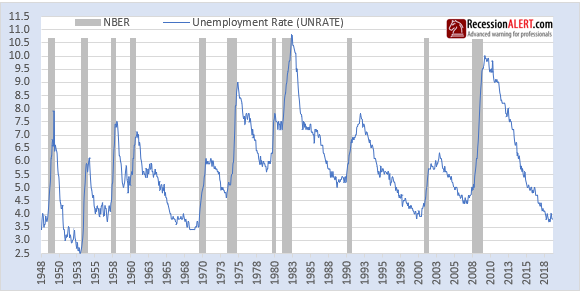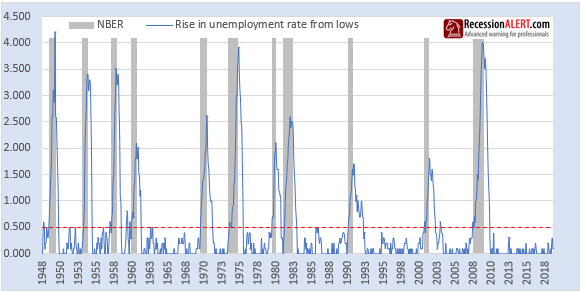The U.S civilian unemployment rate reached new lows of 3.6% in April – numbers last seen 51 years ago in 1968:

There are a number of ways to use the national unemployment rate to signal recession, but almost all of them are co-incident to slightly lagging in the warning they provide.
We have the most commonly used method which is annual growth of the unemployment rate, which has provided about six false positives since 1950 and can lag on occasion due to the long time frame it uses – although it provided timely warnings in the last 3 recessions:

When national unemployment rises more than 0.5% in an economic expansion, it usually signals the start of a U.S recession without any pesky false positives. If we assume 3.6% was the low then this implies a unemployment rate greater than 3.6%+0.5% = 4.1% will be our warning signal:

We prefer to examine the state-level unemployment data which tells us about what is going on “under the hood” of the national unemployment rate. The three metrics we prefer to look at all provide earlier warning signs than the traditional methods and are covered in our monthly Labor Report for subscribers. Here is last months’ reading:

We notice that all three metrics are showing a lot more underlying deterioration and loss of momentum than is currently observable from the national unemployment rate itself. In fact, since March 2014 these metrics have all been climbing steadily, as they did in the prior 5 recessions.
It’s unfortunate that accurate state-level unemployment data is only available going back to 1978 to provide longer term history but this does not detract from the usefulness of these indicators to get a more sensitive reading into what is happening with unemployment.
Despite the visible deterioration in the state-level data it is not panic time yet. More states have to have rising unemployment than those with falling unemployment for the one metric (green line) and both the other two metrics need to stay above 50% before we start hitting the panic buttons.

Comments are closed.